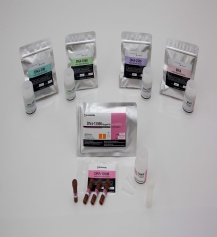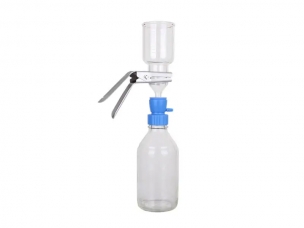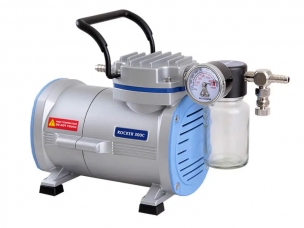Sample Preparation
Product Listing
-
Description:
These glass microfiber filters have three times the thickness of MGA, offering greater wet strength and a significantly enhanced loading capacity. They effectively combine fine particle retention with a favorable flow rate. They are especially beneficial for applications involving liquid clarification or solids measurement in heavily loaded fine particulate suspensions. They can serve as a finely retentive membrane prefilter. These filters are utilized in LSC techniques that demand a high loading capacity. Grade Application MGB Filtration of suspended solids in water, waste water analysis, pre-filters for membranes, suitable for filtration of large volumes. Cross reference: Whatman: GFB ED Scientific Specialities: 121 Advantec: GA-140
OUT OF STOCKThese glass microfiber filters have three times the thickness of MGA, offering greater wet strength and a significantly enhanced loading capacity. They effectively combine fine particle retention with a favorable flow rate. They are especially beneficial for applications involving liquid clarification or solids measurement in heavily loaded fine particulate suspensions. They can serve as a finely retentive membrane prefilter. These filters are utilized in LSC techniques that demand a high loading capacity. Grade Application MGB Filtration of suspended solids in water, waste water analysis, pre-filters for membranes, suitable for filtration of large volumes. Cross reference: Whatman: GFB ED Scientific Specialities: 121 Advantec: GA-140
-
Description:
A bit more retentive than MGA and MG 550 HA, this filter combines excellent particle retention with a good flow rate. It serves as the standard filter for capturing suspended solids in drinking water as well as in natural and industrial waste. In laboratory settings, it allows for quick and effective clarification of aqueous liquids containing low to medium amounts of fine particulates. This filter is utilized in cell harvesting and liquid scintillation counting techniques where a more retentive medium loading capacity is necessary compared to MGA and MG 550 HA. Grade Application MGC Standard filter for the clarification and monitoring of waste water and water, scintillation counting on the filter, cell harvesting, hydrocarbon analysis where cellulose fibers are an inconvinience. Cross reference: Whatman: GFC ED Scientific Specialities: 131 Advantec: GC-50
OUT OF STOCKA bit more retentive than MGA and MG 550 HA, this filter combines excellent particle retention with a good flow rate. It serves as the standard filter for capturing suspended solids in drinking water as well as in natural and industrial waste. In laboratory settings, it allows for quick and effective clarification of aqueous liquids containing low to medium amounts of fine particulates. This filter is utilized in cell harvesting and liquid scintillation counting techniques where a more retentive medium loading capacity is necessary compared to MGA and MG 550 HA. Grade Application MGC Standard filter for the clarification and monitoring of waste water and water, scintillation counting on the filter, cell harvesting, hydrocarbon analysis where cellulose fibers are an inconvinience. Cross reference: Whatman: GFC ED Scientific Specialities: 131 Advantec: GC-50
-
Description:
• Outstanding fine particle retention: ensures effective particle retention when filtering significant volumes. • High-quality borosilicate glass microfiber without binders: supports usage at temperatures as high as 550ºC. • Offered in various dimensions: available in both circle and sheet shapes. • Exceptional loading capacity: able to handle extremely turbid flows. • Minimal fiber shedding: enhances the quality assurance of test results. Cross reference: Whatman: 934 AH ED Scientific Specialities: 161
OUT OF STOCK• Outstanding fine particle retention: ensures effective particle retention when filtering significant volumes. • High-quality borosilicate glass microfiber without binders: supports usage at temperatures as high as 550ºC. • Offered in various dimensions: available in both circle and sheet shapes. • Exceptional loading capacity: able to handle extremely turbid flows. • Minimal fiber shedding: enhances the quality assurance of test results. Cross reference: Whatman: 934 AH ED Scientific Specialities: 161
-
Description:
Grade MG filters can be utilized as filters for wastewater or in the following uses: Monitoring water pollution in effluents Filtering water, algal and bacterial cultures, and proteins Analyzing food products Conducting radioimmunoassays for weak β emitters Performing gravimetric assessments of airborne particles Sampling stacks and employing absorption techniques for air pollution measurements Cross reference: Whatman: GFA ED Scientific Specialities: 111 Advantec: GA-55
OUT OF STOCKGrade MG filters can be utilized as filters for wastewater or in the following uses: Monitoring water pollution in effluents Filtering water, algal and bacterial cultures, and proteins Analyzing food products Conducting radioimmunoassays for weak β emitters Performing gravimetric assessments of airborne particles Sampling stacks and employing absorption techniques for air pollution measurements Cross reference: Whatman: GFA ED Scientific Specialities: 111 Advantec: GA-55
-
Description:
Syringe filter order guideline Choosing the right membrane is important. The wrong membrane could cause loss of valuable samples, time and money. Please use below guideline and chemical compatibility table as reference. Hydrophilic Nylon pH 6-13 Naturally hydrophilic, high protein binding, high dirt-loading, surfactant-free and offer the lowest extractables. Filtering of general samples and organic solvents. Not recommended for use with acids. Hydrophilic PVDF (polyvinylidene fluoride) pH 3-12 Extremely low protein binding. Good chemical compatibility. For filtration of non-aggressive aqueous and mild organic solutions, or when maximizing protein recovery is important. Hydrophilic RC (regenerated cellulose) pH 3-12 Hydrophilic membrane with good solvent resistance. Low protein binding and extractables. Good chemical compatibility with nearly all common HPLC solvents and stable against DMSO. Good for general filtration, tissue culture media filtration or life science applications. Hydrophilic PES (polyethersulfone) pH 3-12 Low protein binding and extractables. Good for life science applications. PTFE pH 1-14 High chemical compatibility. High temperature resistance. Good for filtration of gases, aggressive chemicals, and strong acid. Cellulose Acetate (CA) pH 4-8 Low protein binding For filtration of aqueous solutions Good for applications involving culture media Mixed Cellulose Ester (MCE) pH 4-8 High protein binding Good for general filtration of aqueous solutions.
OUT OF STOCKSyringe filter order guideline Choosing the right membrane is important. The wrong membrane could cause loss of valuable samples, time and money. Please use below guideline and chemical compatibility table as reference. Hydrophilic Nylon pH 6-13 Naturally hydrophilic, high protein binding, high dirt-loading, surfactant-free and offer the lowest extractables. Filtering of general samples and organic solvents. Not recommended for use with acids. Hydrophilic PVDF (polyvinylidene fluoride) pH 3-12 Extremely low protein binding. Good chemical compatibility. For filtration of non-aggressive aqueous and mild organic solutions, or when maximizing protein recovery is important. Hydrophilic RC (regenerated cellulose) pH 3-12 Hydrophilic membrane with good solvent resistance. Low protein binding and extractables. Good chemical compatibility with nearly all common HPLC solvents and stable against DMSO. Good for general filtration, tissue culture media filtration or life science applications. Hydrophilic PES (polyethersulfone) pH 3-12 Low protein binding and extractables. Good for life science applications. PTFE pH 1-14 High chemical compatibility. High temperature resistance. Good for filtration of gases, aggressive chemicals, and strong acid. Cellulose Acetate (CA) pH 4-8 Low protein binding For filtration of aqueous solutions Good for applications involving culture media Mixed Cellulose Ester (MCE) pH 4-8 High protein binding Good for general filtration of aqueous solutions.
-
Description:
Syringe filter order guideline Choosing the right membrane is important. The wrong membrane could cause loss of valuable samples, time and money. Please use below guideline and chemical compatibility table as reference. Hydrophilic Nylon pH 6-13 Naturally hydrophilic, high protein binding, high dirt-loading, surfactant-free and offer the lowest extractables. Filtering of general samples and organic solvents. Not recommended for use with acids. Hydrophilic PVDF (polyvinylidene fluoride) pH 3-12 Extremely low protein binding. Good chemical compatibility. For filtration of non-aggressive aqueous and mild organic solutions, or when maximizing protein recovery is important. Hydrophilic RC (regenerated cellulose) pH 3-12 Hydrophilic membrane with good solvent resistance. Low protein binding and extractables. Good chemical compatibility with nearly all common HPLC solvents and stable against DMSO. Good for general filtration, tissue culture media filtration or life science applications. Hydrophilic PES (polyethersulfone) pH 3-12 Low protein binding and extractables. Good for life science applications. PTFE pH 1-14 High chemical compatibility. High temperature resistance. Good for filtration of gases, aggressive chemicals, and strong acid. Cellulose Acetate (CA) pH 4-8 Low protein binding For filtration of aqueous solutions Good for applications involving culture media Mixed Cellulose Ester (MCE) pH 4-8 High protein binding Good for general filtration of aqueous solutions.
OUT OF STOCKSyringe filter order guideline Choosing the right membrane is important. The wrong membrane could cause loss of valuable samples, time and money. Please use below guideline and chemical compatibility table as reference. Hydrophilic Nylon pH 6-13 Naturally hydrophilic, high protein binding, high dirt-loading, surfactant-free and offer the lowest extractables. Filtering of general samples and organic solvents. Not recommended for use with acids. Hydrophilic PVDF (polyvinylidene fluoride) pH 3-12 Extremely low protein binding. Good chemical compatibility. For filtration of non-aggressive aqueous and mild organic solutions, or when maximizing protein recovery is important. Hydrophilic RC (regenerated cellulose) pH 3-12 Hydrophilic membrane with good solvent resistance. Low protein binding and extractables. Good chemical compatibility with nearly all common HPLC solvents and stable against DMSO. Good for general filtration, tissue culture media filtration or life science applications. Hydrophilic PES (polyethersulfone) pH 3-12 Low protein binding and extractables. Good for life science applications. PTFE pH 1-14 High chemical compatibility. High temperature resistance. Good for filtration of gases, aggressive chemicals, and strong acid. Cellulose Acetate (CA) pH 4-8 Low protein binding For filtration of aqueous solutions Good for applications involving culture media Mixed Cellulose Ester (MCE) pH 4-8 High protein binding Good for general filtration of aqueous solutions.
-
Description:
Syringe filter order guideline Choosing the right membrane is important. The wrong membrane could cause loss of valuable samples, time and money. Please use below guideline and chemical compatibility table as reference. Hydrophilic Nylon pH 6-13 Naturally hydrophilic, high protein binding, high dirt-loading, surfactant-free and offer the lowest extractables. Filtering of general samples and organic solvents. Not recommended for use with acids. Hydrophilic PVDF (polyvinylidene fluoride) pH 3-12 Extremely low protein binding. Good chemical compatibility. For filtration of non-aggressive aqueous and mild organic solutions, or when maximizing protein recovery is important. Hydrophilic RC (regenerated cellulose) pH 3-12 Hydrophilic membrane with good solvent resistance. Low protein binding and extractables. Good chemical compatibility with nearly all common HPLC solvents and stable against DMSO. Good for general filtration, tissue culture media filtration or life science applications. Hydrophilic PES (polyethersulfone) pH 3-12 Low protein binding and extractables. Good for life science applications. PTFE pH 1-14 High chemical compatibility. High temperature resistance. Good for filtration of gases, aggressive chemicals, and strong acid. Cellulose Acetate (CA) pH 4-8 Low protein binding For filtration of aqueous solutions Good for applications involving culture media Mixed Cellulose Ester (MCE) pH 4-8 High protein binding Good for general filtration of aqueous solutions.
IN STOCKSyringe filter order guideline Choosing the right membrane is important. The wrong membrane could cause loss of valuable samples, time and money. Please use below guideline and chemical compatibility table as reference. Hydrophilic Nylon pH 6-13 Naturally hydrophilic, high protein binding, high dirt-loading, surfactant-free and offer the lowest extractables. Filtering of general samples and organic solvents. Not recommended for use with acids. Hydrophilic PVDF (polyvinylidene fluoride) pH 3-12 Extremely low protein binding. Good chemical compatibility. For filtration of non-aggressive aqueous and mild organic solutions, or when maximizing protein recovery is important. Hydrophilic RC (regenerated cellulose) pH 3-12 Hydrophilic membrane with good solvent resistance. Low protein binding and extractables. Good chemical compatibility with nearly all common HPLC solvents and stable against DMSO. Good for general filtration, tissue culture media filtration or life science applications. Hydrophilic PES (polyethersulfone) pH 3-12 Low protein binding and extractables. Good for life science applications. PTFE pH 1-14 High chemical compatibility. High temperature resistance. Good for filtration of gases, aggressive chemicals, and strong acid. Cellulose Acetate (CA) pH 4-8 Low protein binding For filtration of aqueous solutions Good for applications involving culture media Mixed Cellulose Ester (MCE) pH 4-8 High protein binding Good for general filtration of aqueous solutions.
-
Description:
Syringe filter order guideline Choosing the right membrane is important. The wrong membrane could cause loss of valuable samples, time and money. Please use below guideline and chemical compatibility table as reference. Hydrophilic Nylon pH 6-13 Naturally hydrophilic, high protein binding, high dirt-loading, surfactant-free and offer the lowest extractables. Filtering of general samples and organic solvents. Not recommended for use with acids. Hydrophilic PVDF (polyvinylidene fluoride) pH 3-12 Extremely low protein binding. Good chemical compatibility. For filtration of non-aggressive aqueous and mild organic solutions, or when maximizing protein recovery is important. Hydrophilic RC (regenerated cellulose) pH 3-12 Hydrophilic membrane with good solvent resistance. Low protein binding and extractables. Good chemical compatibility with nearly all common HPLC solvents and stable against DMSO. Good for general filtration, tissue culture media filtration or life science applications. Hydrophilic PES (polyethersulfone) pH 3-12 Low protein binding and extractables. Good for life science applications. PTFE pH 1-14 High chemical compatibility. High temperature resistance. Good for filtration of gases, aggressive chemicals, and strong acid. Cellulose Acetate (CA) pH 4-8 Low protein binding For filtration of aqueous solutions Good for applications involving culture media Mixed Cellulose Ester (MCE) pH 4-8 High protein binding Good for general filtration of aqueous solutions.
IN STOCKSyringe filter order guideline Choosing the right membrane is important. The wrong membrane could cause loss of valuable samples, time and money. Please use below guideline and chemical compatibility table as reference. Hydrophilic Nylon pH 6-13 Naturally hydrophilic, high protein binding, high dirt-loading, surfactant-free and offer the lowest extractables. Filtering of general samples and organic solvents. Not recommended for use with acids. Hydrophilic PVDF (polyvinylidene fluoride) pH 3-12 Extremely low protein binding. Good chemical compatibility. For filtration of non-aggressive aqueous and mild organic solutions, or when maximizing protein recovery is important. Hydrophilic RC (regenerated cellulose) pH 3-12 Hydrophilic membrane with good solvent resistance. Low protein binding and extractables. Good chemical compatibility with nearly all common HPLC solvents and stable against DMSO. Good for general filtration, tissue culture media filtration or life science applications. Hydrophilic PES (polyethersulfone) pH 3-12 Low protein binding and extractables. Good for life science applications. PTFE pH 1-14 High chemical compatibility. High temperature resistance. Good for filtration of gases, aggressive chemicals, and strong acid. Cellulose Acetate (CA) pH 4-8 Low protein binding For filtration of aqueous solutions Good for applications involving culture media Mixed Cellulose Ester (MCE) pH 4-8 High protein binding Good for general filtration of aqueous solutions.
-
Description:
Nylon membrane filter, 0.22um , 25mm, 100pcs/pack
IN STOCKNylon membrane filter, 0.22um , 25mm, 100pcs/pack



















